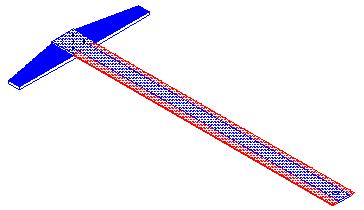Chapter 2 (Part 1)
Equipment and techniques
2.1 Drawing equipment and use of equipments:
A basic set of drawing equipment include following
1. Drawing board
2. T- square
3. Set- square
4. Divider
5. Compass
6. Protractor
7. Pencils
8. Scales
9. French Curves
10. Drawing Pins, Tapes & Clips
11. Drawing Sheet
12. Instrument Box
13. Mini Drafter (Track Drafter Machine)
2.1a T-Square: T-square is used is used to align a piece of paper to a drawing surface, to draw horizontal lines and to support triangles for drawing vertical and angled lines. (Shown in fig (2.1))
2.1b Setsquares: The set-squares (450 and 300/600 triangles) are used to draw vertical and angled lines. The setsquares can be combined to draw angles at 150 intervals. Setsquares are shown in fig (2.5) and the use of setsquares to draw angled lines at 150 intervals is shown in fig (2.6).
2.1c Compass: The compass is used to drawing arcs and circles. Compass is shown in fig (2.3).
2.1d Divider: The divider is used to transfer a measurement from one location to another without remeasuring. A divider is shown in fig (2.2).
2.1e Protractor: The protractor is used for measuring angles and making lines at angles. A protractor is shown in fig (2.4).
2.1f Pencils: Both students & professionals should have a selection of good, well sharpened pencils with leads of various degree of hardness & blackness such as 4H, 2H, HB, 2B & 4B. Like 4H pencil for the light construction lines in drawing where accuracy is required, 2H for repencilling light finished lines (dimension lines, center lines and hidden lines), HB for visible object lines and 2B for lettering & freehand work.
2.1g French curves: “French curves” or “irregular curves” are used for curved lines other than circle arcs.
2.1h Track drafting Machine: Track Drafting machine is used to draw precise horizontal, vertical and angular lines. The drafting machine replaces the T-square, triangles, protractor and scales. This tool allowed the drafter, designer, architect and engineer to work with fewer tools and create larger more precise drawings. This is shown in fig (2.7).
Fig (2.1): T Square
Fig (2.2): Divider

Fig (2.3): Compass Fig

Fig(2.4) Protractor


Fig (2.5): Set Squares




